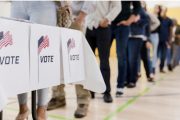
The Los Angeles County Sheriff’s Department confirmed earlier this week that it paid a private company to conduct surveillance flights for nine days in 2012 over the Compton area of southeast Los Angeles, the Los Angeles NBC News affiliate reports.
As has become the custom of law enforcement officials forced to justify their violation of the Fourth Amendment, a spokesman for the LA County Sheriff claimed the purpose of the surveillance was to “enhance public safety and impact criminal activity.”
Some citizens of Compton were not mollified by this statement. “That is a part of our liberty. Come on now. They took it away! You been spying on us?” said former Compton Councilmember Barbara Calhoun, as reported in the NBC story.
Calhoun hit on the key constitutional question. The Fourth Amendment protects the right of the people “to be secure in their persons, houses, papers, and effects, against unreasonable searches and seizures” unless a warrant has been issued based “upon probable cause, supported by oath or affirmation, and particularly describing the place to be searched.”
There’s no threat to liberty, the police promise came in response to the protests of Calhoun and other Compton residents subjected to the warrantless surveillance.
“With respect to concerns about surveillance or being spied on as I know was being reported in the media, the footage that this high altitude camera that was on the bottom of the plane picked up would not make that possible,” Captain Leonard McCray said.
According to the NBC reports, the aircraft that buzzed over Compton were part of the Persistence Surveillance Systems and they are equipped with cameras. The sheriffs said the images were “ineffective” despite having recorded video for more than six hours a day during the exercise.
On its website, Persistence Surveillance Systems boasts of its usefulness in law enforcement:
Persistent Surveillance Systems has assisted law enforcement organizations throughout the United States with over 30 murder investigations since 2007. PSS’s HAWKEYE system and image analysis have direclty led to the apprehension of violent offenders.
Officers have used our imagery to:
1. Backtrack murder suspects to their homes/places of origin
2. Track suspects to every location they went to before, during, and after the crime
3. Identify potential accomplices of the suspect
4. Track each accomplice to every location they went to before, during and after the crime
5. Identify EXACTLY what time and location a suspect or accomplice drove by a ground-based security camera.
6. Dissect entire criminal networks in 3 – 4 days.
With this kind of surveillance circling above them, undoubtedly many Compton residents weren’t satisfied by the sheriff’s department’s “blurry picture” defense. “We might not be able to stop the experiment. But the people of the city of Compton and any city basically they have a right to know that this is at least going on,” Jasmyne Cannick said in the NBC story.
Compton Mayor Aja Brown didn’t exactly condemn the surveillance, though, simply asking the sheriff for more “transparency” in the future. The sheriff seems happy to oblige, particularly since the surveillance in question was conducted two years ago.
“I do agree with the mayor, absolutely, that we should make sure that we do dialogue, and that that information is disseminated,” McCray said. “If for no other reasons just to answer questions that may come up as we’re answering now.”
The promise of transparency in past violations of individual liberty is illusory at best, and likely no more than a smokescreen for future flyovers.
Naturally, the sheriff’s department reiterated that the operations are only necessary as a means to reduce crime and protect citizens.
As The New American has repeatedly revealed, such surveillance has not been shown to reduce crime, but has in fact widened the web of monitoring, much of which has been made possible by technology purchased with money granted to local law enforcement by the Department of Homeland Security (DHS).
Local leaders in Houston, Texas, for example, have approved the installation of new surveillance cameras. These 180 new cameras bring to nearly 1,000 the number of known surveillance cameras in the country’s fourth largest city.
The eye of the government will reportedly cover the city’s “public areas around downtown, stadiums and the theater district.”
Local CBS affiliate KHOU reports on its website that Houston police chief Charles McClelland believes the city needs the nearly 1,000 cameras to “provide necessary police coverage.”
And just where did Houston get the money to buy these new cameras? There’s no provision for the expense in the mayor’s Fiscal Year 2014 budget, so the city’s not paying for these “critical” services so necessary for the “safety” of its citizens.
Department of Homeland Security to the rescue!
In the article announcing the deployment of the new devices, KHOU reports, “The city has spent more than $18 million in federal money to build its camera system and has another $5 million in reserve.”
Perhaps citizens should overlook their elected leaders’ acceptance of such federal largesse, given that the 900 or so surveillance cameras already in place have had such a favorable effect on crime rates in the city.
Not so much.
Again, from KHOU: “Officials say data is not kept to determine if the cameras are driving down crime.”
The same story is told in city after city. Citizens are surreptitiously being fenced inside an invisible Panopticon where every movement is watched, tracked, and recorded by some government entity, whether local or federal or a combination of the two.
In 2012 when these missions were conducted over Compton, the sheriff’s department used traditional fixed wing aircraft. What if a similar sortie were flown today? Would drones be the vehicle of choice?
The LA County Sheriff’s Department has been using drones since 2006. In 2013, it was reported that the unmanned aircraft were used by LA law enforcement in its search for Christopher Dorner.
During the 2006 drone tests, the sheriff’s department was bullish on the possible uses of the devices.
“We’re really beyond the cutting edge,” said sheriff’s Cmdr. Sid Heal, as reported in USA Today. “We think this has great potential.”
This exuberance was on display in a statement made in 2012 by a spokesman for the Harris County, Texas sheriff’s department. This agency bought a $300,000 ShadowHawk drone in 2012.
“We envision a lot of its uses primarily in the realm of public safety — looking at recovery of lost individuals and being able to utilize it for fire issues,” Chief Deputy Randy McDaniel said. But in the future, the drone could be equipped to carry nonlethal weapons such as Tasers or a bean-bag gun, McDaniel mused.
The potential weaponization of police drones is an important issue, one that combines both constitutional issues of due process and the Fourth Amendment’s search and seizure limitations.
Glenn Greenwald, formerly of Salon, warned of the likelihood of the gradual shift in the use of drones from surveilling suspects to shooting them: “Many dismiss this concern insisting that when it comes to surveillance drones are no different than police helicopters. Some of these same people dismiss concerns over weaponized drones arguing that there’s no difference between allowing the police to Taser you or shoot you themselves and using a drone to do the dirty work. History teaches, however, that creeping police state powers are entrenched one step at a time.”
Although the weaponization of drones by law enforcement has not been reported, Dr. Daniel Goure of the Lexington Institute wrote about the fact that the Switchblade drone popular with law enforcement is more than just an eye in the sky; it can also be a gun. “It is an ingenious, miniature unmanned aerial vehicle (UAV) that is also a weapon,” Goure said.
Taking such comments at their face value, it must be asked, what level of weaponization is permissible for the police? Does local law enforcement need the type of weaponry used by the military, whose mission is very different from that of law enforcement?
If police are already justifying the surveillance by pointing to the potential for crime reduction, how long until they extend that excuse to cover the killing of a “suspect?”
Americans in Compton and cities across the country are right to ask these questions.
Joe A. Wolverton, II, J.D. is a correspondent for The New American and travels nationwide speaking on nullification, the Second Amendment, the surveillance state, and other constitutional issues. Follow him on Twitter @TNAJoeWolverton and he can be reached at [email protected].




